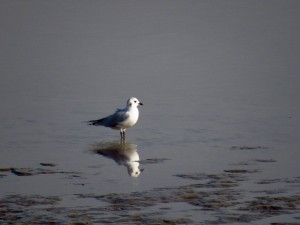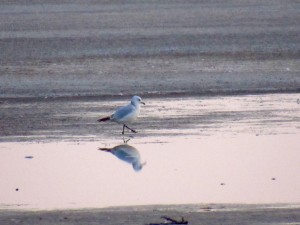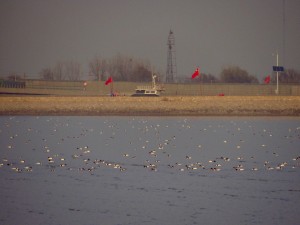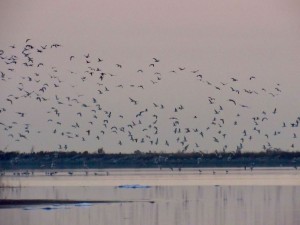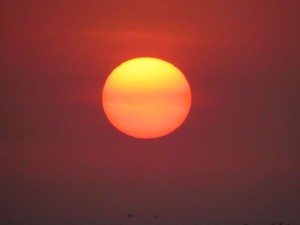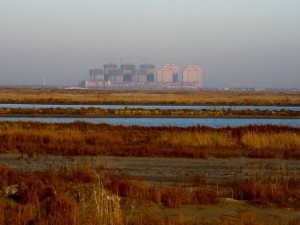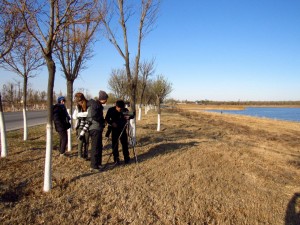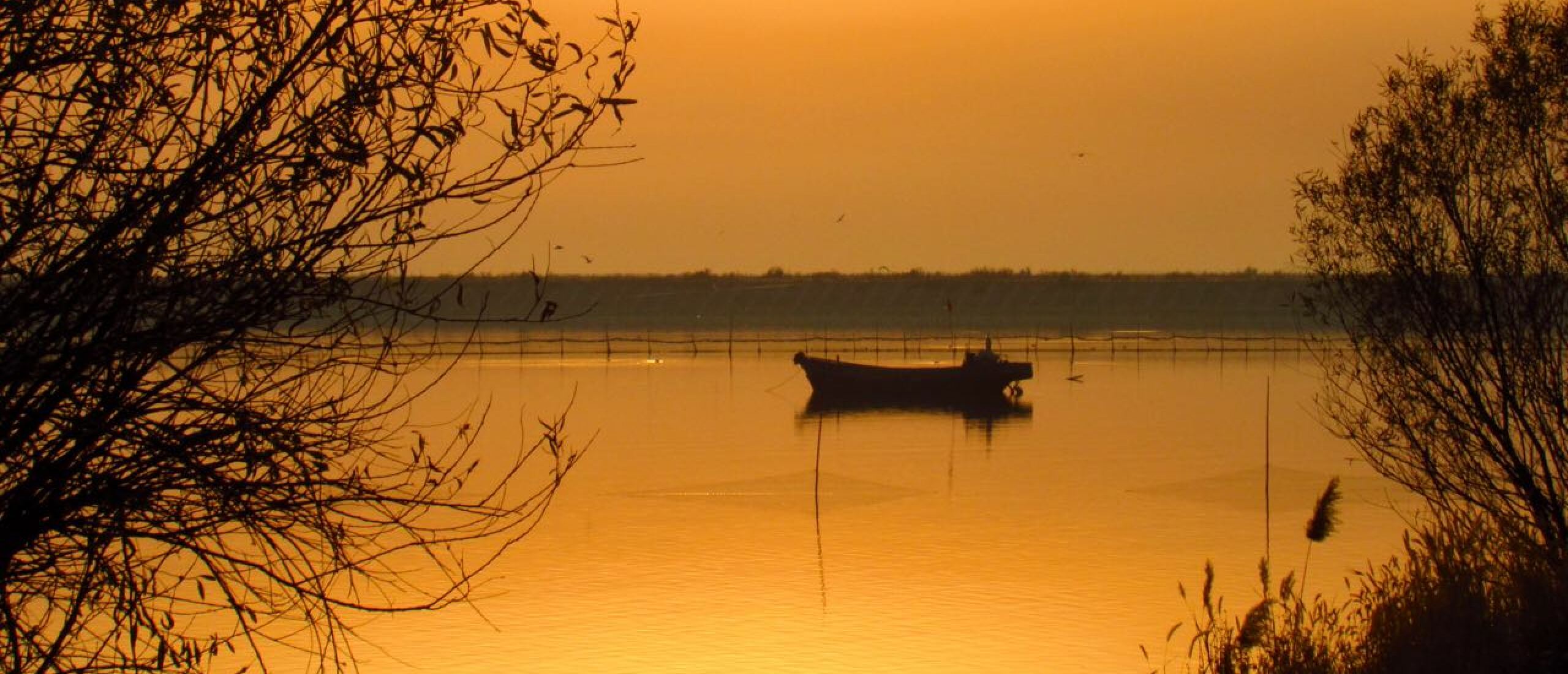
Into the frozen North Last weekend was one of the highlights of my time in China to date. Friday afternoon saw me hurrying to Shanghai to meet a group of birdwatchers and to catch the bullet train for a 1000km journey north to Tianjin, a vast metropolis with 15.5 million inhabitants and apparently the sixth largest city on Earth. The journey took just 3 hours and 20 minutes, indicating that our average speed was well over 300kph. The most noticeable difference was immediately apparent when we stepped out of the train: a dramatically lower temperature. Luckily we were able to find a taxi fairly quickly, and we were soon in the warmth of our hotel, where we spent the night before a really great day of birding. We piled into our minibus in the morning, and headed out through the seemingly endless industrial outskirts of Tianjin, aiming for the renowned site of Beidagang, a reservoir to the south-east of the city with large areas of reed and a convenient causeway across the middle that facilitates watching on both sides. An icy temperature greeted us when we stepped out of the vehicle, but once the sun started exerting its influence, the bright weather and large numbers of birds combined to lift our spirits. The Chinese members of the group (all but two) were excited by a group of Mute Swans, and a huge flock of Avocets attracted our attention in the far distance, along with large numbers of Goosanders and other ducks far away across the lake.
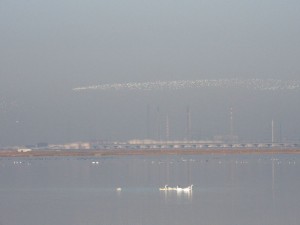 A huge flock of Avocets flies over the Beidagang lake, with Mute Swans in the foreground
A huge flock of Avocets flies over the Beidagang lake, with Mute Swans in the foreground
 Industry rarely seems to be out of sight while birdwatching in China
Industry rarely seems to be out of sight while birdwatching in China
My attention was quickly drawn to a by now familiar call on the other side of the causeway, in the reeds. I immediately recognized this as perhaps the bird I most wanted to see here in eastern China, the enigmatic and endangered Reed Parrotbill. I had missed it on my two visits to Nanhui, a well-known site near Shanghai, and I was determined to see it this time. Searching for reed-loving birds can often be frustrating, but it was not long before a long-tailed bird with whirring wings flew across and landed in full view near the top of some reeds, and there was my first “lifer” of the weekend. We later went on to see at least twenty of these unusual-looking birds, with their stumpy yellowish bill, grey head with a bold, curving black eyestripe and long, graduated tail. This species is endangered due to the ongoing destruction of reedbeds, and I was delighted to acquaint myself with this very special bird.
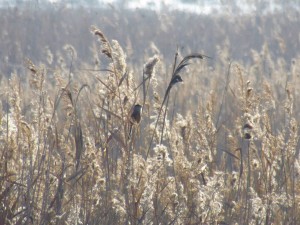 Reed Parrotbill was a bird I had long hoped to see
Reed Parrotbill was a bird I had long hoped to see
 The causeway provided excellent views over the lake on one side and reeds on the other
The causeway provided excellent views over the lake on one side and reeds on the other
We then reached the far end of the lake, and headed on up a parallel road. A look away over the reeds revealed some very large but very distant white birds, and a telescope examination confirmed my second “lifer” of the trip, another endangered species and one that I had long dreamt of seeing, the stately Oriental White Stork. We finally managed to see up to 100 of these magnificent birds, a very significant proportion of the entire World population of perhaps 3000 birds. Larger than the European White Stork, and with a black rather than a red bill, and a piercing white eye, this bird is still on the decline. It breeds in north-eastern China and adjoining parts of Russia. It is apparently still illegally hunted, as well as suffering from the destruction of its nesting trees, collisions with power cables (one bird we saw had one of its legs dangling uselessly beneath it as it flew past), and poisoning. Apparently over thirty of these storks were found poisoned here in 2012, victims of the extraordinary method of poaching of ducks and geese that occurs frequently in China; surely eating birds that have been poisoned can hardly be a healthy option for humans, yet still it goes on.
 The large white birds in the distance turned out to be Oriental Storks
The large white birds in the distance turned out to be Oriental Storks
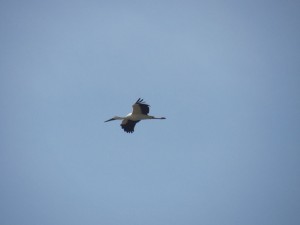 The Oriental Stork is larger than its much commoner European cousin
The Oriental Stork is larger than its much commoner European cousin
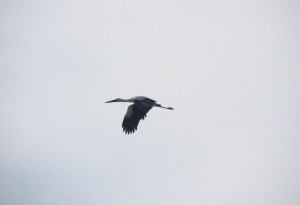 The black flight feathers of the Oriental Stork show a whitish area on the upper side
The black flight feathers of the Oriental Stork show a whitish area on the upper side
 A group of Eurasian Spoonbills, with a flock of Bean Geese beyond
A group of Eurasian Spoonbills, with a flock of Bean Geese beyond
While watching these storks, along with large numbers of Bean Geese, my third “lifer” of the day appeared, perched on top of a signpost: a Chinese Grey Shrike. Larger and with more extensive white on the wing than the similar Great Grey Shrike, this bird was distant but clearly identifiable, and I savoured my view of this attractive species.
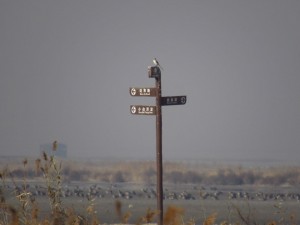 A distant Chinese Grey Shrike posed on a signpost
A distant Chinese Grey Shrike posed on a signpost
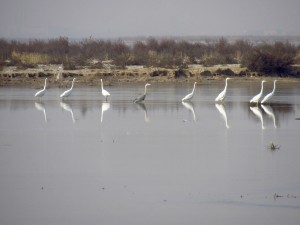 A stately group of Great White Egrets and a Grey Heron provided a beautiful composition
A stately group of Great White Egrets and a Grey Heron provided a beautiful composition
After a photo stop with one of the staff members of this reservoir reserve, we headed off towards the coast of the Bohai Gulf, and we stopped at a scruffy area near the seawall. Unfortunately, the tide was way out, and other than a few Eurasian Curlews it seemed at first that we were not destined to see much here, but soon a small gull flew along, looking similar to the familiar Black-headed Gull, but smaller, and with a shorter, more stubby black bill, another vulnerable species, the Saunders’s Gull.
I was already familiar with this attractive little gull, which I used to see in small numbers in Japan, but here we were treated to views of perhaps twenty individuals, a privilege considering that the total population of this bird probably does not exceed 15,000 to 20,000 individuals. More exciting still was a line of more distant gulls, the species that we had really come here to see, the Relict Gull. This species breeds around high-altitude salt lakes in Mongolia, Kazakhstan and adjacent parts of China and Russia, with an estimated population of around 10,000 birds. Until recently, it was not really known where the majority of these birds spend the winter. I saw it in Korea in the winter of 1990, at a most beautifully peaceful site at the mouth of the Naktong River, near Pusan; that place is now totally destroyed and converted into a huge container port. Now, however, it has been revealed that up to 7,000 of these delightful birds winter on the mudflats of the Haibin coast.
From here, we headed along the heavily developed coast on a major road, and at one point I was very surprised to find myself looking at the former Soviet aircraft carrier Kiev, which was bought by a Chinese company after the collapse of the Soviet Union and is now the centrepiece of the Tianjin Aircraft Carrier World theme park.
 The ex-Soviet aircraft carrier Kiev. Photo courtesy Binhai Aircraft Carrier Themepark
The ex-Soviet aircraft carrier Kiev. Photo courtesy Binhai Aircraft Carrier Themepark
We finally checked another series of coastal pools, where we enjoyed a spectacular sunset and large numbers of Common Shelducks, before driving 120kms or so northwards to our hotel for the Saturday night, in Tangshan.
 Even industrial landscapes can have a surprising beauty
Even industrial landscapes can have a surprising beauty
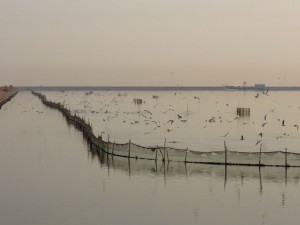 The nets here attracted large numbers of gulls
The nets here attracted large numbers of gulls
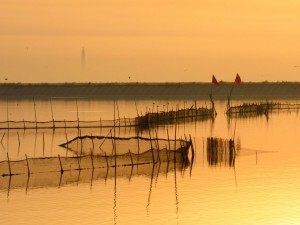 The evening light was spectacular
The evening light was spectacular
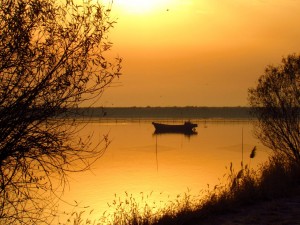 A tranquil scene in the sunset
A tranquil scene in the sunset
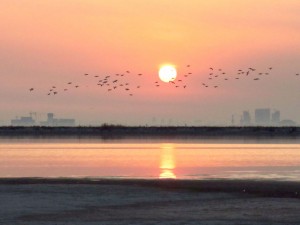 Shelducks against the evening sun
Shelducks against the evening sun
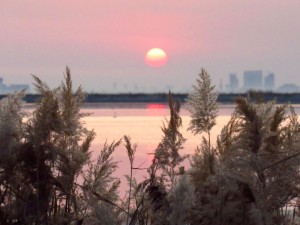 The sun slipped down beyond the reeds
The sun slipped down beyond the reeds
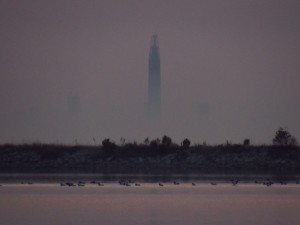 A vast new skyscraper thrusts its way upwards into the evening sky
A vast new skyscraper thrusts its way upwards into the evening sky
Sunday morning saw us leaving our hotel, with its spectacular mural of Napoleon, at around 6.00AM, and a short drive took us towards the Bohai coast, where we found that it was colder than the previous morning, with a bitter wind, and it was with some reluctance that we emerged from our minibus on the windswept expanse of the Caofeidian marshes, a peninsula that juts out into the Bohai Gulf.
 An impressive mural of Napoleon graced the lobby of our hotel
An impressive mural of Napoleon graced the lobby of our hotel
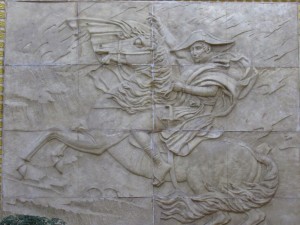 Large numbers of both White-naped and Red-crowned Cranes are supposed to winter here, but all we found was one distant Common Crane, that flew off long before we could approach it. A digger in the distance was an ill omen, and it later emerged that even though this is a Provincial Nature Reserve, it has recently been designated as the site of a future petrochemical plant. What are we humans doing? I find it utterly extraordinary that one of the last areas of relatively natural marshland on the whole of this coast, home to some of the rarest and most culturally significant birds, should be earmarked for destruction. A road is already under construction through the middle of this “reserve”, and the theory is that this disturbance has already frightened the cranes away. But where can they go when almost everywhere else is wrecked?
Large numbers of both White-naped and Red-crowned Cranes are supposed to winter here, but all we found was one distant Common Crane, that flew off long before we could approach it. A digger in the distance was an ill omen, and it later emerged that even though this is a Provincial Nature Reserve, it has recently been designated as the site of a future petrochemical plant. What are we humans doing? I find it utterly extraordinary that one of the last areas of relatively natural marshland on the whole of this coast, home to some of the rarest and most culturally significant birds, should be earmarked for destruction. A road is already under construction through the middle of this “reserve”, and the theory is that this disturbance has already frightened the cranes away. But where can they go when almost everywhere else is wrecked?
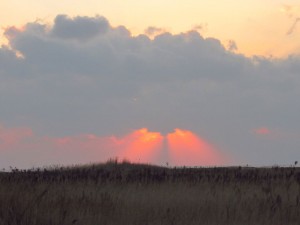 An icy sunrise over the Bohai Gulf
An icy sunrise over the Bohai Gulf
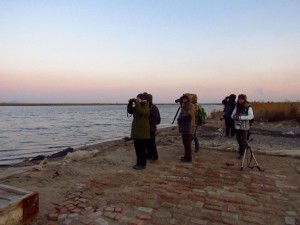 Only one Common Crane was to be seen, where White-naped Cranes should have been
Only one Common Crane was to be seen, where White-naped Cranes should have been
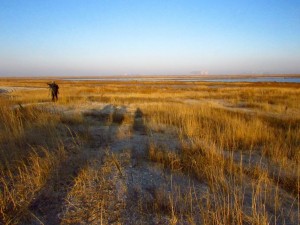 Site of a future petrochemical plant. What are we doing?
Site of a future petrochemical plant. What are we doing?
Disappointed, we headed back towards Tianjin, and stopped for lunch in an almost deserted motorway rest area. Very few birds were visible from the road, and I was becoming despondent, thinking that we were destined to see nothing for the rest of the day. However, little did I know that we would be stopping at the Tuanbowa reservoir, and the bright sunshine and large numbers of birds here soon improved my mood. The commonest species here was the Eurasian Coot, with Mute Swans and Great Crested Grebes adding to the homely feel. More interesting to me, however, were considerable numbers of Falcated Teal, a delightful bird that I used to see frequently on the lakes around Tokyo. Wigeon, Common Teal, Gadwall, Goosander, Goldeneye and large numbers of Smew were also here, and we spent some time scoping out across the lake in search of rarer species.
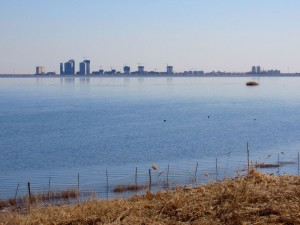 Tuanbowa Reservoir attracts numerous waterbirds
Tuanbowa Reservoir attracts numerous waterbirds
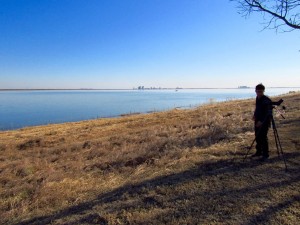 A telescope was necessary to identify the more distant birds
A telescope was necessary to identify the more distant birds
It was near the end of our time here, after we had moved to the northern end of the lake, that Nemo, our local guide, spotted a small group of Ferruginous Ducks close to the reeds on the far shore, and with them, two similar birds with whitish flanks. Unfortunately, they were asleep, and we could not see their heads, but we were almost certain that these were another drastically endangered species, the Baer’s Pochard. BirdLife International’s factsheet on this duck states: This species is classified as Critically Endangered as it is apparently undergoing an extremely rapid population decline, as measured by numbers on both the breeding and wintering grounds. It is now absent or occurs in extremely reduced numbers over the majority of its former breeding and wintering grounds and is common nowhere. It is thought that hunting and wetland destruction are the key reasons for its decline. Population size: 150-700. By this time, excitement was high, but time was low, as we still had to reach Tianjin station in time to catch our trains home. However, just as we were about to leave, Nemo spotted another very special bird which swam through his telescope view as he was hoping that one of the almost-certain Baer’s Pochards would raise its head to clinch its identification: a splendid male Baikal Teal. This delightful little duck, with its green head and complicated yellow face pattern, was thought to be highly endangered until the late 1980s, when a number of vast flocks were discovered in South Korea, where over 95% of the global population overwinters. I had visited two of those lakes in the winter of 1990, and marveled at the vast concentration of these birds, which has been estimated at 400,000 individuals. Even to see one was a fitting end to this excellent weekend, and I look forward to birding again with this group at some future date.


